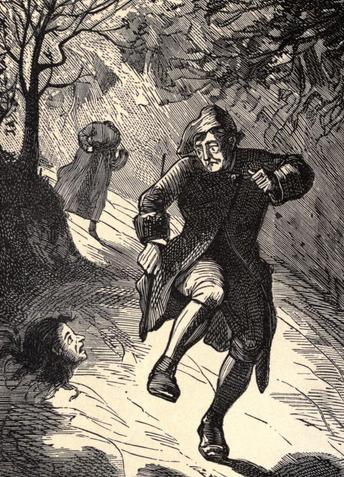The boggart (aka boggard, buggard, buggart, baggard) is a solitary fairy associated with the north-west. Boggarts break down into two general categories. There are domestic boggarts, those that haunt houses and that frequently indulge in poltergeist activity, and there also those that haunt a road, a bridge or a field out in the wilds. Note that the word ‘haunt’ is used advisedly here as there is often confusion about whether a boggart is a ghost or a fairy or perhaps, somehow, both. Certainly, there are cases from the eighteenth and nineteenth century where supernatural beings that we would call ghosts are termed, instead, ‘boggarts’. Boggarts are often associated with water: why this should be is a mystery. Likewise, they are said to eat small fairies: owl pellets were interpreted as the bones of fairies devoured and excreted by boggarts! They also devoured fern, a plant with fairy associations and a plant that supposedly encouraged invisibility. It was generally felt that animals could see boggarts more easily than humans and when a horse became frightened it was said that the animal had seen a boggart (‘taken boggart’). It should finally be noted that even in a domestic setting boggarts tended to be unfriendly towards human neighbours and some were downright hostile.
Home region: The boggart originally was a part of the folklore of the English north, the English Midlands and parts of the Marches. However, by the nineteenth century the boggart had become a fairy associated above all with Lancashire and the South Pennines
Physical Description: Boggarts are sometimes humanoid (there are a handful of references to naked men), they sometimes appear in animal form, and, above all, they are shapeshifters, moving between different shapes. Some have the notable talent of detaching and throwing their head after their victims (see image at head of post).
Earliest Attestation and etymology: There are sixteenth-century reference to boggarts. The word boggart probably comes from a related and more general term bogle. It is possible that there is a Celtic term lurking in the background, though this is far from clear.
Boggart Locations: There are literally scores of boggart places in the North West. However, Towneley Boggart Bridge between Burnley and Todmorden and Boggart Hole in Pendle Forest and Boggart Hole Clough to the north of Manchester are three famous Boggart haunts.
Boggart Sighting: A particularly vivid boggart encounter comes from the life of Samuel Bamford: as noted above it is not clear whether this particularly boggart is ghost or fairy!
Boggart Story: The most famous boggart story of all, though it is associated with several northern fairies, is the flit.
Boggart sayings: ‘To take boggart’ [a horse shies and flees]; ‘Turn up like Towneley’s Boggart’ [make an unexpected and not particularly pleasant appearance, related to a Burnley legend]
Popular Culture: The boggart was all but forgotten in traditional-lore when it made an suprising come-back via, first, children’s writer Susan Cooper (The Boggart), and then the Harry Potter series.


